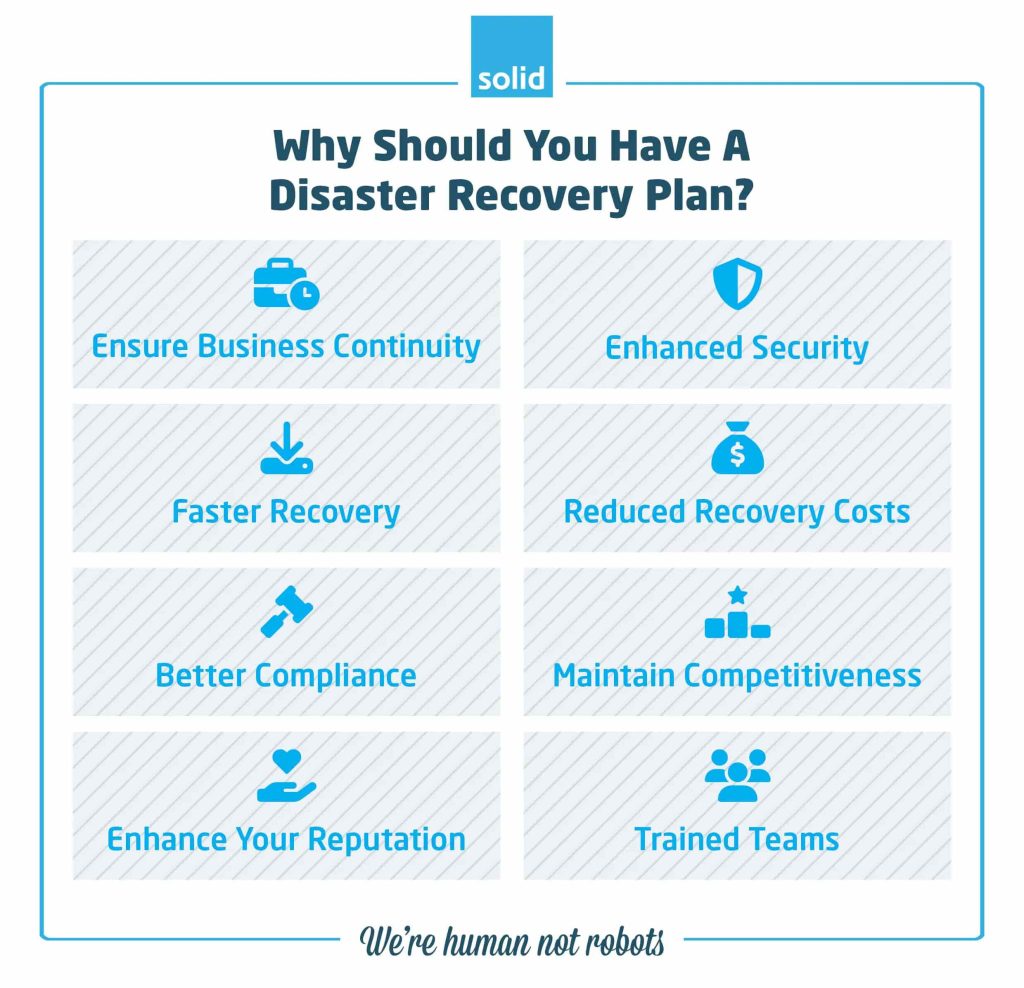
In today’s digital age, data is the lifeblood of any business. The loss or compromise of important files and information can have significant economic and reputational consequences. With many companies moving their data into the cloud, and an increase in cybersecurity threats and their sophistication, it is essential for businesses to have a robust disaster recovery plan in place.
What Is Cloud-Based Disaster Recovery?
A lot of businesses that are adopting cloud computing into their processes are misguided into believing that data stored in the cloud is already backed up. If you’re using solutions like Microsoft 365, OneDrive and SharePoint, you may already consider your data to be completely safe. After all, if it becomes compromised, it’s easily recoverable, right? Not quite.
While Microsoft tools do allow for data recovery, documents in your recycle bin are set to permanently delete after just 28 days as a standard. And while you can certainly adjust that time frame, it’s important that your business also have backups of critical information stored in case of disaster. For example, if an attacker were to gain access to your Microsoft environment, if you didn’t have second (or even third) copies of the files that they now have access to, you wouldn’t have any choice but to give into their demands or put your company at risk of a data breach.
Cloud-based disaster recovery (DR) is a method of backing up and restoring your business’ critical data and apps through the use of cloud resources. Instead of relying on traditional on-premises backups, companies can now store copies of their critical data in the cloud, allowing them to recover quickly in case of a disaster.
How Does Disaster Recovery As A Service Work And What Are The Benefits?
Disaster Recovery as a Service (DRaaS) is a cloud-based service that offers continuous replication of your data and systems, ensuring that you can recover quickly in case of a disaster. It works by taking snapshots of your system at regular intervals, and keeping them stored in the cloud. In case of an outage or disaster, these snapshots can be used to restore your systems and data to the point of the last snapshot, ensuring minimal downtime for your business.
The benefits of DRaaS are plenty. It offers a high level of reliability, ensuring continuous availability of your data, even when faced with outages, system failures, or disasters. By replicating systems and data at regular intervals, DRaaS provides a robust safety net, ensuring minimal downtime and business disruption, securing your critical data against cyber threats and promoting regulatory compliance by aligning recovery objectives with industry standards. The scalability of cloud services also allows businesses to adjust their storage requirements as needed, and simplifies disaster recovery management, freeing up your IT team to focus on strategic business initiatives.
Companies will often work with cloud partners like Solid Systems to set up DRaaS solutions, ensuring that their critical data is automatically and regularly backed up, and ready to be recovered if a disaster ever strikes.
What Are The Different Types Of Disaster Recovery Available?
There are various types of cloud-based disaster recovery options available, each with its own benefits. Let’s take a look at some of the most common ones:
• Backups
Backups are copies of your data that can be used to restore in case of data loss or corruption. In the past, companies would rely on physical backups like tapes or external hard drives, which could be time-consuming and often not up to date.
• Backups As A Service
Backups as a Service (BaaS) is a cloud-based solution that automates and simplifies the backup process for businesses. Instead of manually backing up data, BaaS automatically stores copies of your data in the cloud, allowing for quick and easy recovery.
• Disaster Recovery As A Service
DRaaS goes beyond just backing up data. It offers continuous replication of your entire system and infrastructure to the cloud, ensuring that you can recover quickly and seamlessly in case of an outage or disaster. DRaaS also includes testing and monitoring of your system to ensure that everything is functioning properly.
• Point-In-Time Snapshots
Point-in-time snapshots are similar to backups, but they allow for more granular recovery options. Instead of just restoring the entire system from the last backup, point-in-time snapshots allow you to restore from a specific moment in time, making it easier to recover from data corruption or human error.
• Virtual Disaster Recovery
Virtual disaster recovery involves creating a virtual copy of your infrastructure in the cloud, often to an Infrastructure as a Service (IaaS) platform like Microsoft Azure or a Virtual Machine. This allows for quick and efficient recovery in case of an outage, as you can quickly switch over to the virtual environment and continue operations while your on-site systems are being restored.
• Disaster Recovery Sites
Disaster recovery sites involve having a secondary location where your systems and data are replicated and stored. This is often used by larger businesses with critical systems that cannot afford any downtime. In case of a disaster at the primary site, operations can continue seamlessly from the disaster recovery site.
What Is A Disaster Recovery Plan, And Why Should You Have One?

A Disaster Recovery Plan is a detailed strategy for how to react to disastrous situations, whether it’s a cyberattack, a fire, extensive loadshedding, and more. It covers in detail how your data is backed up, which cloud backup or other services you’re using, who is responsible for backup and recovery, which data should be recovered as a priority, training your teams in how to recognise attacks, and more.
Having a thorough cloud-based disaster recovery plan offers numerous benefits for protecting your information, systems, and operations. Some of the main benefits include:
• Ensure Business Continuity And Resilience
Having a strategy in place ensures that your business can quickly recover from any unexpected events or disasters. This helps to minimise downtime and maintain operations even when a disaster occurs, allowing you to remain resilient and continue serving your customers without your business grinding to a halt.
• Enhanced Security
A well-planned disaster recovery plan includes measures for data security and protection, including encryption, early detection, and Identity and Access Management (IAM). This helps to safeguard your information against cyberattacks, natural disasters, human error, and other risks that could compromise your systems. Add to that the fact that DR Plans can help your teams to not only recognise potential attacks, but know exactly how to respond to them and who to turn to when a disaster strikes, and it’s easy to see how having a thorough plan in place can boost your company’s overall security standing.
• Faster Recovery
With an efficient cloud-based disaster recovery plan, your systems and operations can be back up and running in a much shorter period of time. This is because all the necessary steps have already been mapped out beforehand, allowing for a swift response to any disaster that does occur.
• Reduced Recovery Costs
In the event of a disaster, the cost of recovering your systems and operations can quickly add up. However, with a well-planned disaster recovery strategy in place, these costs can be significantly reduced. By having backups and other measures in place, you can avoid costly downtime and data loss, and are less likely to be compromised by ransomware attacks. There’s no need to pay an attackers ransom, after all, when you can quickly and easily restore your data to the point before they were compromised.
• Better Compliance
Many industries have strict regulations when it comes to data protection and security. By having a comprehensive disaster recovery plan in place, you can ensure that you are meeting these regulations and avoiding any potential penalties or fines. In fact, some industries may even require a disaster recovery strategy as part of their compliance standards.
• Maintain Competitiveness
In today’s digital landscape, downtime can be detrimental to a company’s success. With a strong disaster recovery plan in place, your business can minimise downtime and maintain a competitive edge. Customers will appreciate the reliability of your systems and operations, and you’ll be able to continue operating without significant interruptions.
• Enhance Your Reputation
A disaster can severely damage a company’s reputation. By having a plan in place for recovering your data, you can mitigate the effects of any potential disasters and maintain trust with your customers. This is especially important in industries where trust and reputation are critical, such as healthcare, finance, and government.
• Trained Teams
Having a disaster recovery plan also often means having trained teams who are ready to react in the event of an emergency. These teams will be well-versed in the steps that need to be taken to quickly recover systems and operations, minimising downtime and reducing the potential impact of a disaster. With regular testing and training, these teams will be well-prepared to handle any situation that may arise.
What Disaster Recovery As A Service Option Is Right For Your Business?
When it comes to choosing a cloud-based disaster recovery solution for your business, there are various options available to fit your specific needs and budget. Here are the three main types of DRaaS options:
• Managed DRaaS
With managed DRaaS, a third-party provider will handle all aspects of your disaster recovery, from planning and implementation to monitoring and testing. This option is best for businesses that don’t have the resources or expertise to manage their own disaster recovery plan.
• Assisted DRaaS
Assisted DRaaS is a hybrid option where the third-party provider will work closely with your in-house IT team to manage data recovery. This option allows for more control and involvement from your own team while still leveraging the expertise of a dedicated DRaaS provider.
• Self-Service DRaaS
Self-service DRaaS gives businesses complete control over their disaster recovery plan, allowing them to manage and monitor it themselves. This option is best for businesses with a strong IT team and the resources to handle their own disaster recovery plan.
How Can Solid Systems Help?
Solid Systems offers a variety of cloud-based disaster recovery and cloud computing solutions, tailored to fit the specific needs and budgets across a vast range of industries including healthcare, finance, and government. Our team of experienced and certified IT Pros can work with you to assess your current disaster recovery plan and determine the best option for your business, or to create a DR Plan for your business which addresses your unique needs. With our managed IT services, cloud solutions and backup and recovery options, you can rest assured that your data and systems are protected by state-of-the-art technology and a team of experienced professionals. Schedule a free IT consult with us today to learn more about how we can help ensure the continuity of your business in the event of a disaster. Remember, when it comes to disaster recovery, it’s not a matter of if, but when – so make sure you’re prepared with Solid Systems on your side.
Frequently Asked Questions
The initial step in cloud-based disaster recovery is conducting a thorough assessment of your current IT infrastructure. This involves identifying critical systems and data that need protection, understanding the potential risks and vulnerabilities, and defining the recovery objectives. This information then informs the design of a tailored disaster recovery plan.
The three main items to consider when it comes to planning your disaster recovery are your Recovery Point Objective (RPO), which defines the maximum acceptable amount of data loss measured in time; your Recovery Time Objective (RTO), which sets the acceptable amount of time to restore the function after the disruption; and the Disaster Recovery Plan itself, a documented process or set of procedures to recover and protect a business IT infrastructure in the event of a disaster.
Waiting until disaster has struck is too late to implement disaster recovery. While there will be options available to you, they will often come at a high cost if your data has already been compromised, and will see your operations grinding to a halt. You need to start your disaster recovery planning early by conducting a comprehensive risk assessment and business impact analysis, outlining your recovery objectives, developing a detailed plan, and documenting the steps to recover critical IT systems. Test the plan regularly to ensure its effectiveness. Lastly, review and update the plan routinely to account for changes within your business.
Popular Searches
- IT companies in gauteng province
- Advantages of Cloud Infrastructure
- Data Migration
- Productivity Tools in Microsoft 365
- Cyber Security Threats To Financial Sector
- Cloud Scalability Benefits
- Backup VS Disaster Recovery
- IT company Midrand
- Types of Cyber Attacks
- IT Infrastructure with Cloud Computing
- SaaS Solutions
- Microsoft SharePoint Vs OneDrive
- Advantages Of Disaster Recovery Plans
- Data Integrity Threats
- IT support in centurion
- IT support in pretoria





